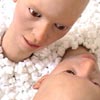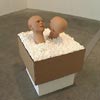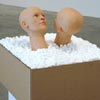|



more
|
Ken Feingold's new works are literally capable of carrying on
conversations. Written with his original forms of software
Feingold's listening and speaking animatronic heads - digitally and
pneumatically activated lifelike silicone portraits - hear and
understand english speech. They take art into the realm of the inter-
personal encounter, moving toward and questioning the unpredictability
and complexity that language and mind create between people (as well as
between people and computers), presenting new concepts of the portrait,
and pointing to issues of artificial intelligence and biological
engineering.
Two of the works also involve digital projections in which the screens
are the "mental projections" of the figures, video inside-out; that is,
the inner "imaginary" workings of these figures, and how people interact
with them, control what is seen. Image and sound in these works are
emotional signs and symptoms emitted by the characters. Some of the
interaction will take place in the gallery, while in one of the works
the public will be given a way into the mind of the figure via the
Internet.
The conversations which these figures carry on are neither completely
scripted, nor are they random; rather, the software gives each a
"personality", a vocabulary, associative habits, obsessions, and other
peculiarities, which make their conversations quirky, surprising,
and often hilarious.
In "If/Then" (2001) two identical heads, sculpted in the likeness of an
imaginary androgynous figure, speak to each other, doubting the reality
of their own existence. These two, in ever-changing and outrageous
conversations with each other (and anyone who might care to try to get a
word in) struggle to determine if they really exist or not, if they are
the same person or not, and if they will ever know. They try to draw
visitors into their endless, twisting debate over whether this clumsy
self-awareness and the seemingly illusory nature of their own existence
can ever be really understood.
Another, titled "Sinking Feeling"(2001) is a single head, quite convinced of
its own existence, but desperate to know "Why don't I have a body like
everyone else?" or "How did I get here, what am I doing here?" The
"cognition" of this figure is made visible in a projection - the ones
who speak with it literally see both their own words as they are heard
by this figure, and in the formulation of a reply, something of the
head's "thought process". That he is growing out of flower pot also points to
questions about biological engineering and human parts as cash crops.
Like Feingold's work "Head"(1999), commissioned by the Kiasma Museum of
Contemporary Art, Helsinki,"Sinking Feeling" draws gallery visitors
into a one-on-one conversation with a complex artificial life form.
In the jury statement from Vida 3.0 (a recent international competition
on artificial life held by Fundacičn Telefčnica, Madrid, in which Feingold's
"Head" was a prize winner),
"Feingold chooses to explore the zones of non-response, of
mischief and misbehavior, or distortion, of scrambled and
failed communication. [It] makes us question the basis of
everyday dialogue we tend to take for granted: how far is
our exchange with others conditioned and limited by our own,
thoroughly encoded eccentricities, our own programmed bugs
and quirks? When indeed true communication occurs, how much
is this just a matter of chance?"
The third work, an installation titled "Self Portrait as the Center of
the Universe"(2001), takes up and extends the themes of Feingold's work
"S*ance Box No. 1"(1998-99), shown in the "net_condition" exhibition at
ZKM Karlsruhe in 1999. Not only possessed of the ability to understand
speech, this head and his puppet companions transmit sightings of the
agent provocateur adrift before them, and their endless conversations.
These conversations, bridging real and virtual spaces, are within scenes
which recompose themselves, populated by figures - autonomous "software
agents" - which appear in the projected image-world that fills his vision.
Other characters, who temporarily "get into his head"", gain entry via the
a website at http://www.kenfeingold.com/hinge. Realtime video server provided
courtesy of The Thing, NYC.
Those who are wandering around, bumping into things, change what is seen and
heard in the installation, while gallery visitors find themselves not only
Surrounded in a territory where the inner imaginings of this disembodied portrait
are visible, but able to talk with the head and the autonomous agents
about it all.
|
|


